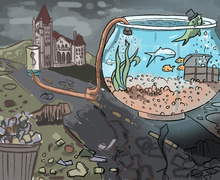Bird Library was built 45 years ago. Now, the building’s future is uncertain under the Campus Framework plan.
Casey Russell | Head Illustrator
Syracuse University’s Bird Library will celebrate its 45th anniversary this month. The future of the building, however, is uncertain.
SU officials are considering Chancellor Kent Syverud’s major Campus Framework infrastructure project, which details future campus development. The Campus Framework aims to redesign Bird to create more of a social space for collaborative learning, officials have said, including a new addition that would extend the library toward Walnut Park.
The university, though, does not have a concrete plan for what will happen to Bird, said Sarah Scalese, associate vice president of university communications.
The latest draft of the Campus Framework, released in May, only details some tentative plans for the library, including the new expansion.
Original plans for the library only detailed how it would function until the 1989-1990 academic year, according to university records. The library did not go through major renovations for more than 30 years, until its lower floors were redesigned in 2014.
“It’s a building of a certain vintage” but is still in good shape structurally, said David Seaman, dean of University Libraries.
Bird can be redesigned because there are no major walls supporting the structure, Seaman said. The building is supported by columns.
Though the university has proposed a glass-backed addition facing Walnut Park, Seaman said renovations for Bird are still in the early planning stages. A construction timeline will most likely not be released for another year or two, he added.
There is no guarantee that anything detailed in the Campus Framework draft will happen because it is a “visioning document” rather than a plan, Seaman said.
Current construction concepts show an extension of the library toward Walnut Park, but other versions expand the building toward the Schine Student Center, the Einhorn Family Walk or all three, Seaman said.
Mary Anne Ocampo — a principal at Sasaki Associates, the architecture firm that conceptualized designs for the Campus Framework — said Bird was a catalytic project for the university because of its position on campus and its importance.
Ocampo said the firm looked at ways it could engage the physical environment to respond to the needs of the university. Bird is built on a hill, so the firm was determining how to make it accessible to the campus and Waverly Avenue.
Bird Library was built in the 1960s and ‘70s, she said, so the Campus Framework looked at how to revamp an older building to accommodate books, digital services and physical interactions.
The philosophy is that the library should become more people-oriented. There is a real demand right now for collaborative and technologically-capable spaces, Seaman said.
In the past, Bird had a pedestrian bridge, said Russell King, an architect of Bird Library with King + King Architects. The bridge was removed to make room for library administrative offices, but the framework has again proposed building a pedestrian bridge.
“Thinking about expanding the library is really a testament to its place in the university, both as a research center and as a center for student success and student life,” Seaman said.
SU’s library system started after the university purchased the Von Ranke collection, a set of manuscripts from historian Leopold von Ranke. Carnegie Library was built in 1907, when the student population was a fraction of what it is now.
The population at SU boomed in the post-war years as soldiers returned home, either attending the university or raising children who could. The university welcomed World War II veterans under the GI Bill of Rights and enrollment “tripled overnight,” administrators have said.
“It was crazy,” King said of the student population growth under the GI Bill. “I think there were maybe 3,000 students, and the next thing you know there are 15,000.”
King started studying at the School of Architecture in 1947. He was one of two students in a class of about 30 people who was not studying under the GI Bill, he said.
Carnegie Library, the central library on campus at the time, could not accommodate or fit the growing population.
In 1950, Carnegie held more than 400,000 books. That number grew 280 percent by 1969, according to John Robert Greene and Karrie Anne Baron’s “The Planning and Funding of the E.S. Bird Library.”
There were other libraries on campus, and books were dispersed in several academic buildings, but Carnegie was the primary hub.
William Tolley, chancellor from 1942 to 1969, championed SU libraries. His “Syracuse Plan,” a fundraising campaign that would last through the 1960s, called for $8 million to build a “Central University Library,” per Greene and Baron.
“It was very much the chancellor at the time who made building a massive research library his legacy,” Seaman said.
King described Tolley as a “great visionary” and “fantastic man” multiple times. The two worked together on multiple projects, including Bird.
Before starting the project, university leaders requested King and other architects of King + King travel across the United States to look at other newly-built college libraries at schools such as Harvard University and the University of California, Los Angeles, King said.
The campus was expanding toward Walnut Park, so King + King wanted Bird to be a central part of the growth, he said.

Courtesy of Syracuse University Archives
Beginnings of construction for Bird Library.
The library’s namesake, Ernest Stevenson Bird, graduated from SU in 1916. Under the “Syracuse Plan,” contributions of a specific amount would allow the donor to receive deferred payments from SU.
For the library’s construction, Bird and his wife, Marie, donated the assets of two investment bank accounts — valued at about $2.5 million — plus additional funds to total $3 million, Greene and Baron wrote.
“You couldn’t probably reproduce it today for $150 million, 45 years later,” King said.
In total, $15 million was needed to complete Bird, he added.
During his time as chancellor, Tolley helped increase the university’s assets by $185 million and the school’s endowment by $51 million, per The New York Times. Under his leadership, Bird was built. He died in 1996.
Tolley’s legacy is deeply entwined with that of King + King. The chancellor worked with the architects on Flint Hall, Day Hall, Shaw Hall, Huntington Beard Crouse Hall, Newhouse 1, the Physics Building, Link Hall and more structures on SU’s campus.
King + King’s legacy at the university goes deeper than its work with Tolley. The firm’s founder, Archimedes Russell, designed Crouse College. King said he apprenticed for the architect who designed Hall of Languages, the first building built on campus.
SU’s building philosophy was red brick and limestone for a while, King said.
What made Bird special, he said, was its cast-in-place mix of concrete. The heavy concrete exterior contributes to the library’s “brutal style,” a type of architecture from the mid-20th century that emphasizes raw concrete.
The library has made several changes since it opened in 1972. Bird was built to hold large collections of physical objects and accommodate growth, Seaman said, but the library is no longer collections-focused.
Bird was built for the future. The architects left spaces so the building could accommodate extra wiring if needed in the future, King said.
Architects did not account for the internet or wireless devices, King said, but the columns supporting the building allow the library to be open, and things can be moved as needed.
“The point is, it works because the building is very flexible,” King said.
Bird is “the heart of the campus,” Seaman said.
“You only need to walk into this building at 8 o’clock at night to see that we’ve been successful in providing a space for students to socialize and study,” he said.
Published on September 26, 2017 at 1:19 am
Contact Kennedy: krose100@syr.edu | @KennedyRose001





